

7 Advancements That Have Changed Diabetes Treatment and Management
In a few short decades, type 2 diabetes research and technological breakthroughs have brought about significant advancements in how the condition is treated and managed. Here are some of the top innovations that are helping people with type 2 diabetes better manage the condition today.
1. Insulin pumps: The first insulin pump came on the market in 1974. If you have diabetes and have to inject insulin multiple times a day, a pump is an alternative to self-injection. An insulin pump is a medical device that delivers insulin into the tissue just underneath the skin.
This computerized device, which is about the size of a deck of cards, can be worn around your waist, put in a pocket, secured with an armband, or attached to a belt or bra. An insulin pump can also be more convenient if you’re out or at work, because all you may need to do is push a button to deliver the insulin instead of prepping a syringe and giving yourself a shot.
2. Continuous glucose monitors: (CGMs) These devices have a tiny sensor that is placed below the surface of the skin to measure the amount of glucose in the fluid between cells every few minutes and transmit the data wirelessly to a device or your smartphone.
CGMs are a game changer: Unlike glucose meters that require a drop of blood to check what your blood glucose levels are at that moment, CGMs monitor your levels at set times throughout the day, such as every 5 minutes. This can help you and your doctor identify patterns and trends that may be helpful in fine-tuning your diabetes treatment plan to optimize management. These devices can also alert you when your glucose level is too low or too high.
The first CGM, which involved wearing a device provided by the doctor for two weeks or less and then returning it to the clinic or hospital, was approved by the Food and Drug Administration (FDA) in 1999. Since then, CGMs have become increasingly accurate and much more widely available for home use. In the past 5 years, there have been even more advances in CGM devices.
The benefit of using a CGM is that it can be worn for 10 or more days, which means one poke to insert the monitor [during that time frame] replaces checking blood sugars via a finger poke 3 or more times per day. CGMs make it easier to check your blood sugar before and after meals, and they can help you understand how your diet, activity, and lifestyle affect your blood sugar levels.
3. Connected CGM-insulin pumps: Another option available is a combination CGM-insulin pump, which enables the pump to use the data from the CGM to suggest changes in medication dosing or make necessary adjustments on its own. In June 2020, the FDA approved an integrated CGM, which allows it to be connected to other diabetes management devices, such as insulin pumps and blood glucose monitors.
This integration of devices can help improve type 2 diabetes management by quickly reducing blood sugar and minimizing the amount of time you experience unsafe and unhealthy blood sugar levels.
4. Diabetes medications: Although insulin has been used in the United States since the 1920’s, today’s medications can be far more targeted for specific diabetes issues.
Metformin, which belongs to a class of medications called biguanides, is often the first medication prescribed for type 2 diabetes. Sodium-glucose cotransporter-2 (SGLT2) inhibitors are oral medications that lower blood sugar levels by preventing the kidneys from absorbing glucose. Glucagon-like peptide-1 receptor agonists (GLP-1 RAs) are injectable medications that help you control appetite and blood sugar levels. Combination therapies join multiple drug classes in a single medication. They may be injected or taken orally.
5. Insulin innovations: Insulin has come a long way since it was first discovered. It now comes in a variety of forms, including rapid-acting, long-lasting, and premixed formulas, and can be delivered via a number of methods, such as syringes, pumps, and pens. And innovations are still coming. For instance, there are now insulin pen devices that can remember the last dose and the time that it was given, which is especially helpful if you’re busy or tend to forget to take it. Smart insulin pens have many of the features of insulin pumps but cost less and don’t have to be attached to your body. Smart insulin pens can connect to your smartphone or watch and diabetes data tracking platforms to help you accurately calculate each dose based on factors such as your blood sugar level, carb amounts, meal size, and other parameters prescribed by your doctor. These devices can also remind you to take your dose, keep track of the amount of each dose, and tell you when your insulin has expired.
6. Easier-to-use glucagon: Glucagon is used in emergencies to treat very low blood sugar, or hypoglycemia, a dangerous condition that can lead to confusion, loss of consciousness, seizures, and even death. Glucagon injections have been available for more than 20 years, but in the past few years, devices such as injectable pens and glucagon that can be inhaled have made it much easier for you — or your family or friends — to administer glucagon in the event of an emergency.
7. Better support for people with diabetes: In the past, many people with type 2 diabetes were treated by their primary care physician — rather than an Endocrinologist, who has special training in the complexities of type 2 diabetes management. Diabetes educators can also connect you to dietitians, and mental health experts trained to help with the condition.
Ajay Varanasi, MD, FACP, FACE
Director, Tampa Bay Diabetes, Thyroid & Endocrinology Center
Assistant Professor, Morsani School of Medicine, University of South Florida
Adjunct Clinical Professor, Lake Erie College of Osteopathic Medicine